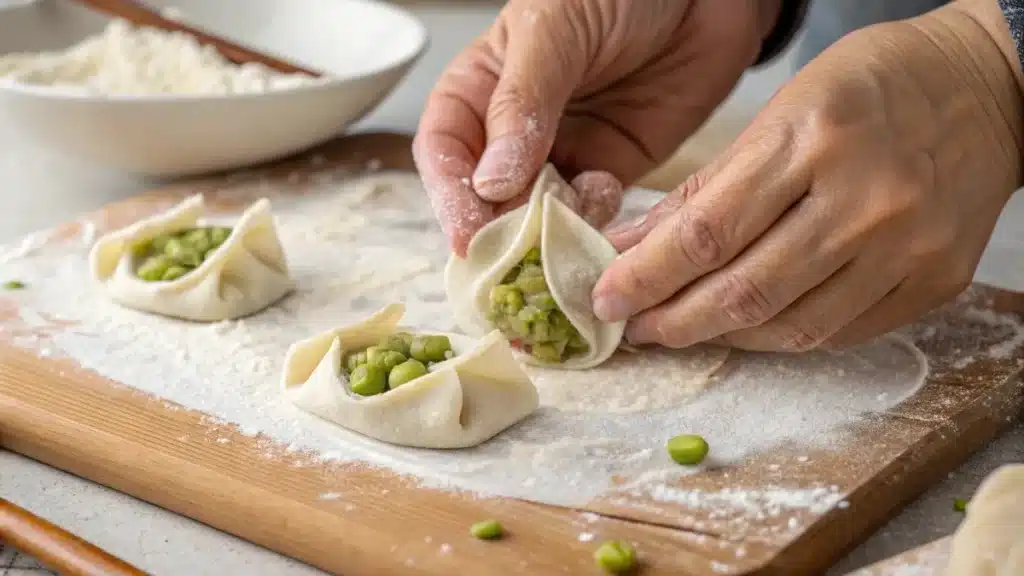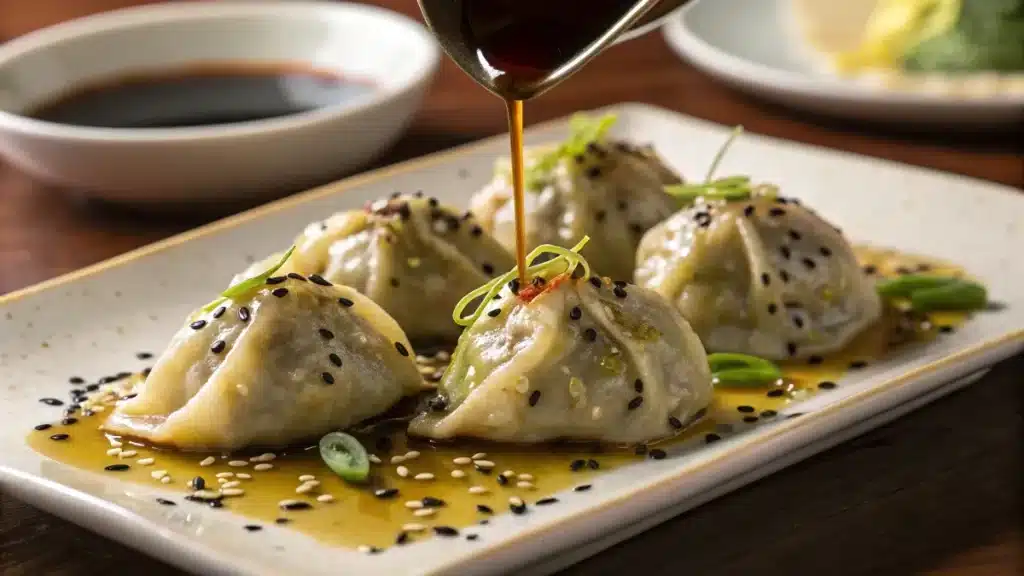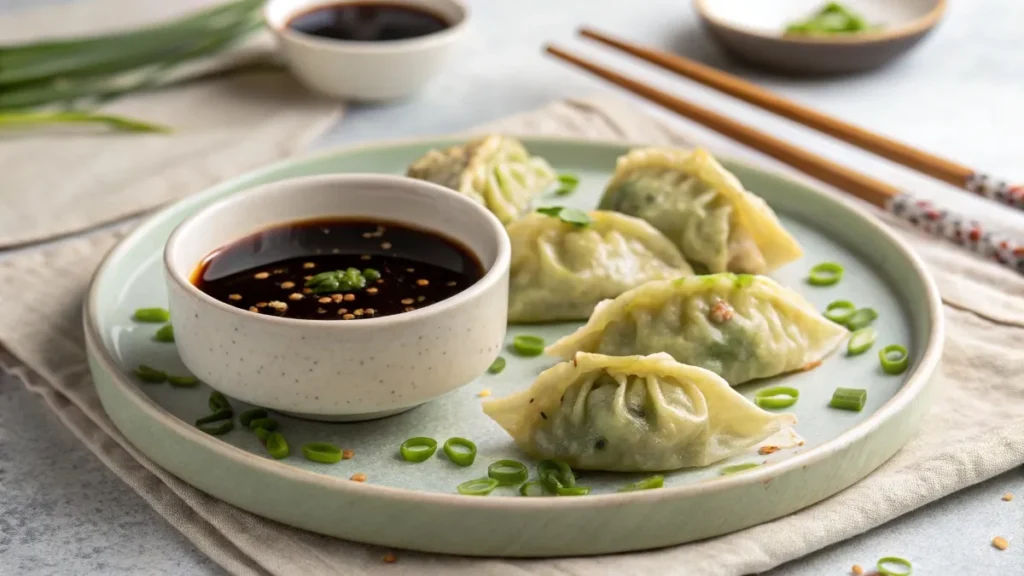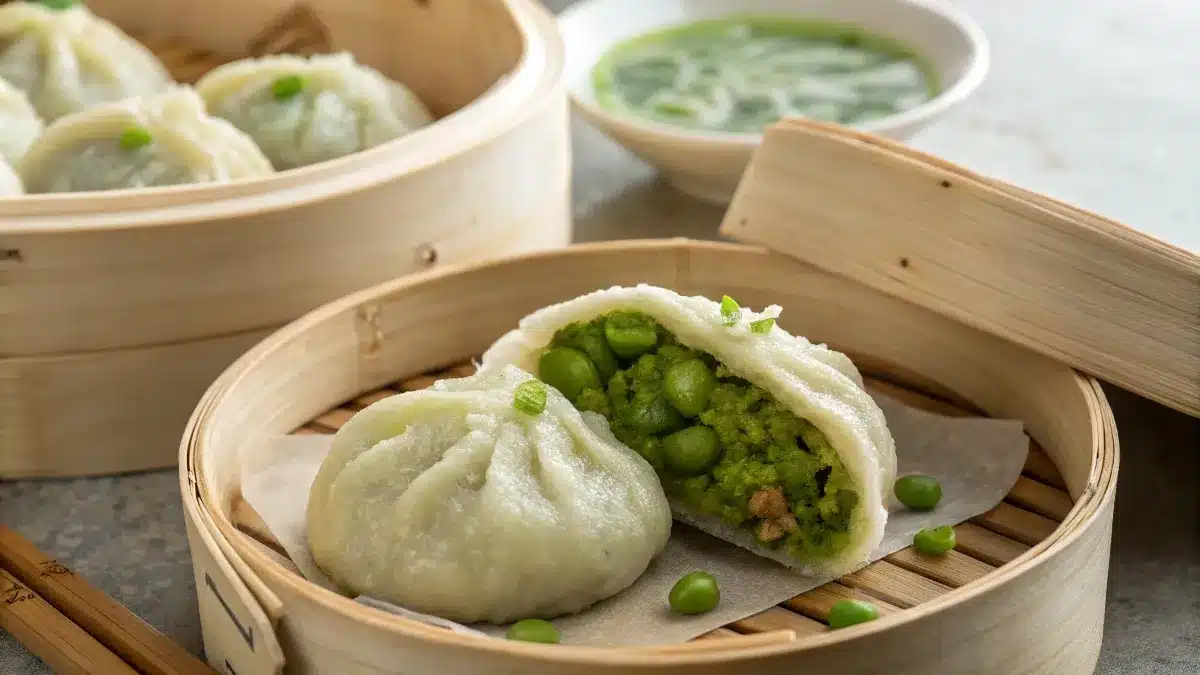Edamame Dumpling Recipe: The Ultimate Guide to Healthy, Flavor-Packed Dumplings
Edamame dumplings have gained popularity in contemporary kitchens, offering a nutritious, plant-based, and flavor-rich twist on classic dumplings that appeals to health-conscious foodies. This detailed guide will walk you through everything about edamame dumpling recipes—from their health benefits to gluten-free adaptations, truffle-infused variations, cooking techniques, and serving ideas. Whether you’re a novice in the kitchen or a seasoned chef, you’ll find practical tips to master this dish. Looking for inspiration? Try easy edamame recipes to complement your dumplings.
Table of Contents
Introduction to Edamame Dumplings
What Are Edamame Dumplings?
Edamame dumplings are a delightful twist on the classic dumpling, featuring a savory filling made primarily from edamame, or young soybeans. These vibrant green beans are blended with flavorful herbs, spices, and sometimes other veggies or aromatics to create a smooth yet chunky filling. The dumplings can be wrapped in traditional or gluten-free wrappers, then steamed, pan-fried, or boiled to perfection.
Edamame dumplings originated in Asian-inspired fusion cuisine but have become popular globally due to their plant-based goodness. They cater to vegans, vegetarians, and anyone seeking a lighter, nutrient-dense dumpling option.
The Rise of Edamame Dumplings in Modern Cuisine
The popularity of edamame dumplings reflects a growing trend toward health-conscious and sustainable eating. Diners are increasingly seeking meals that deliver both nutrition and taste without compromising on dietary preferences like vegan, gluten-free, or dairy-free.
Restaurants and home cooks alike love edamame dumplings because they’re versatile—you can tweak the fillings, the wrappers, and the cooking method to suit different diets. Their subtle, nutty flavor pairs beautifully with ingredients like truffle oil, garlic, ginger, and sesame.
In fact, many chefs highlight edamame dumplings as a go-to appetizer in upscale Asian-fusion menus. The vibrant green color and soft, creamy interior make them as visually appealing as they are tasty.
In the next part, we’ll dive into the health benefits of edamame dumplings—why these little pockets of goodness deserve a spot in your meal rotation.
Health Benefits of Edamame Dumplings
Are Edamame Dumplings Healthy? Exploring Nutritional Value
Edamame dumplings pack a nutritional punch. Edamame is rich in plant-based protein, making these dumplings an excellent option for vegans and vegetarians. They’re also loaded with fiber, supporting digestion and helping you feel full longer.
These dumplings are naturally low in saturated fat and cholesterol. Edamame contains antioxidants and essential nutrients like folate, iron, and vitamin K. When paired with light cooking methods like steaming, edamame dumplings become a nutrient-dense choice that fits well into a balanced diet.
Comparing Edamame Dumplings to Traditional Dumplings
Compared to meat-based dumplings, edamame dumplings are lighter and lower in calories. They have less saturated fat and offer more fiber. Traditional dumplings often use pork or beef, which ups the fat content. In contrast, edamame provides heart-healthy fats and keeps the dish plant-based.
When made with gluten-free wrappers, edamame dumplings also suit people with gluten intolerance. Discover great ideas like gluten-free soft pretzels to round out your meal.
In the next section, we’ll break down the key ingredients you need to create a standout edamame dumpling recipe.
Ingredients for Edamame Dumpling Recipe
Key Ingredients You’ll Need (Edamame, Gluten-Free Options, Truffle Oil)
The heart of this edamame dumpling recipe is, of course, the edamame. You’ll want shelled, cooked edamame for a smooth filling. Garlic, ginger, scallions, and sesame oil add depth of flavor. To elevate the dish, a drizzle of truffle oil brings a gourmet touch.
While traditional dumpling flour is commonly used, gluten-free wrappers are an excellent choice for anyone avoiding gluten. Rice flour or a blend of rice and tapioca flours are excellent alternatives. Check out Pillsbury gluten-free flour as a reliable option for homemade wrappers.
Finding the Best Gluten-Free Substitute for Dumpling Flour
If you’re skipping wheat, several substitutes work well. Rice flour creates a soft, delicate dumpling skin. Tapioca starch adds chewiness. A mix of these gives the best texture. Chickpea flour can work too but has a stronger flavor.
Blending gluten-free flours with xanthan gum helps replicate the stretch and flexibility of classic dumpling dough. Don’t miss our discover the best gluten-free shortcake for more gluten-free inspiration.
Step-by-Step Edamame Dumpling Recipe

Preparing the Edamame Filling
Start by blending cooked edamame in a food processor until slightly chunky. Add minced garlic, grated ginger, chopped scallions, and a splash of sesame oil. For extra richness, mix in a small amount of truffle oil if desired. Season with salt, pepper, and a dash of soy sauce or tamari for a gluten-free option.
Taste the filling and adjust seasoning. The mix should be flavorful and moist but not watery. Chill the filling for 10 minutes to firm it up—this makes wrapping easier.
How to Fold and Seal Dumplings Like a Pro
Place a wrapper on a clean surface. Spoon about a teaspoon of filling in the center. Moisten the edges of the wrapper with water. Fold into a half-moon, pressing out air as you seal.
For a decorative touch, pleat the edges starting from one corner. Press firmly so the dumplings don’t open while cooking. Set each dumpling on a tray lined with parchment paper as you go.
Looking for inspiration? Try gluten-free king cake if you’re planning a full gluten-free feast.
Truffle Edamame Dumplings Variation
How to Make Truffle Edamame Dumplings
Adding truffle oil to your edamame dumpling recipe is a game changer. Simply stir a teaspoon of truffle oil into your prepared filling right before wrapping. This adds a rich, earthy aroma that pairs beautifully with the nutty edamame.
When cooking, steam or lightly pan-fry the dumplings. The gentle heat helps preserve the delicate truffle flavor. Serve hot to maximize the aroma and taste.
Flavor Pairings for Truffle Edamame Dumplings
Truffle edamame-dumplings shine when paired with simple sauces. For dipping, mix light soy sauce with rice vinegar and a hint of sesame oil for added depth.
For a more decadent option, drizzle extra truffle oil over the cooked dumplings before serving. A sprinkle of toasted sesame seeds or fresh chives adds the perfect finishing touch.
Don’t miss our gluten and dairy free dessert ideas to round out your meal.

Cooking Methods for Edamame Dumplings
Pan-Fried, Steamed, or Boiled: Which Method is Best?
Each method brings out different qualities in edamame-dumplings. Pan-frying gives them a crispy bottom with a tender top. Steaming creates soft, juicy dumplings that highlight the filling’s flavor. Boiling offers a lighter bite and works well for soup dumplings.
For truffle edamame-dumplings, steaming is often preferred. It preserves the delicate aroma of the truffle oil while keeping the wrapper silky.
Tips for Achieving Perfect Texture
Regardless of how you cook them, make sure not to overcrowd the steamer or pan to ensure even cooking. This ensures even cooking and prevents sticking. Use parchment paper or cabbage leaves under dumplings when steaming to stop them from sticking.
If pan-frying, add a splash of water and cover the pan after crisping the bottom. This lets them steam and finish cooking through.
Check out easy edamame recipes for more ideas on how to enjoy this versatile ingredient.
Gluten-Free Dumpling Solutions
Can You Make Dumplings Without Gluten?
Absolutely. Edamame dumplings can be fully gluten-free with the right wrappers. Use rice flour, tapioca starch, or a blend to create elastic, smooth dumpling skins. Pre-made gluten-free wrappers are available in many stores, or you can make them at home with a little practice.
Filling-wise, edamame is naturally gluten-free. Just be sure to use tamari or coconut aminos instead of soy sauce for seasoning.
Gluten-Free Substitute for Suet and Dumpling Flour
Traditional suet can be swapped with vegetable shortening or chilled coconut oil for a plant-based, gluten-free option. For flour, rice flour or a rice-tapioca mix works great. Some cooks also use almond flour or chickpea flour, though these change the flavor slightly.
For an easy starting point, discover great ideas like Pillsbury gluten-free flour that make gluten-free cooking simpler.
Serving Suggestions and Sauces
What Do Edamame Dumplings Taste Like?
Edamame dumplings offer a gentle, nutty sweetness from the young soybeans, while a blend of garlic, ginger, and scallions brings a warm, savory depth to the filling. When you include truffle oil, the taste takes on an earthy richness that lingers.
The dumpling wrapper itself is soft and slightly chewy, creating a satisfying contrast with the creamy filling. Whether steamed, fried, or boiled, the overall flavor is delicate, making them easy to pair with various sauces.
Best Sauces and Dips for Edamame Dumplings
A traditional dipping sauce combines soy sauce and rice vinegar for a tangy, savory kick. If you need a gluten-free option, tamari or coconut aminos are excellent alternatives. For a spicy touch, stir in a bit of chili oil. Want something creamier? Try sesame paste or peanut sauce for a rich, smooth finish.

For an elevated touch, drizzle a bit more truffle oil or sprinkle toasted sesame seeds before serving. Don’t miss our discover the best gluten-free shortcake to end your meal on a sweet note.
Storing and Reheating Edamame Dumplings
How to Store Leftovers for Freshness
Store cooked edamame dumplings in an airtight container in the fridge. They’ll stay fresh for up to three days. If you’re making a batch ahead, freeze uncooked dumplings on a tray until solid, then transfer them to a freezer bag. This keeps them from sticking together.
Freezing preserves texture and flavor. When ready to cook, you can steam or pan-fry straight from frozen—no need to thaw.
Reheating Tips Without Losing Flavor
For refrigerated dumplings, steaming is the best method to reheat without drying them out. Just a few minutes will do. If you prefer a crisp bottom, reheat in a lightly oiled pan, covering with a lid and adding a splash of water to create steam.
Avoid microwaving, as it can make the wrappers tough or soggy.
Conclusion
Making your own edamame dumpling recipe at home is easier than you might think. Whether you’re after a healthy, plant-based snack or a gourmet truffle-infused appetizer, these dumplings deliver on flavor and nutrition. With gluten-free options and simple folding techniques, anyone can master this dish.
Don’t miss our easy edamame recipes to expand your plant-based cooking skills. Ready to impress at your next meal? Give these dumplings a try and enjoy every flavorful bite.
FAQs
Are edamame dumplings healthy?
Yes, edamame dumplings are a healthy choice. Thanks to the edamame, these dumplings are rich in plant-based protein, fiber, and health-boosting antioxidants. When steamed or lightly pan-fried with minimal oil, they offer a low-calorie, nutrient-dense meal.
How to make truffle edamame dumplings?
To make truffle edamame dumplings, simply blend your edamame filling and stir in a teaspoon of truffle oil before wrapping. This infuses the dumplings with an earthy aroma. Steam or pan-fry to preserve the delicate flavor of the truffle.
What do edamame dumplings taste like?
Edamame dumplings have a mild, nutty flavor with hints of sweetness from the soybeans. The garlic and ginger add warmth, while truffle oil gives them a luxurious, earthy depth.
Can you make dumplings without gluten?
Yes, you can make dumplings without gluten. Use rice flour, tapioca starch, or gluten-free store-bought wrappers. These alternatives create soft, chewy dumpling skins that hold up well during cooking.
What is a gluten free substitute for suet?
Chilled coconut oil or vegetable shortening are great gluten-free, plant-based substitutes for suet. They provide the fat needed for tenderness without using animal products.
What is a substitute for dumpling flour?
Rice flour, tapioca starch, or a blend of both are the best substitutes for traditional dumpling flour. They mimic the elasticity and softness of wheat-based doughs.

